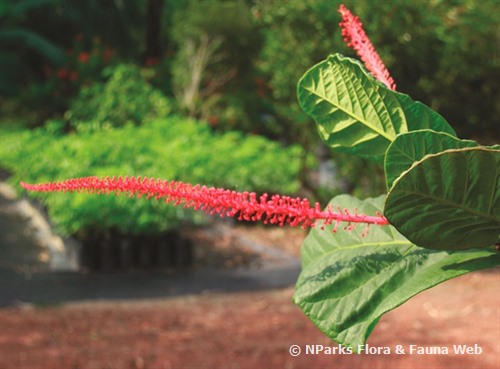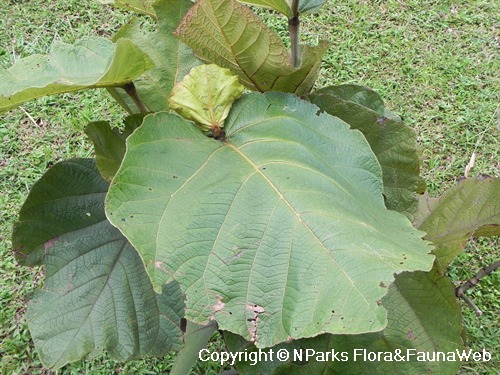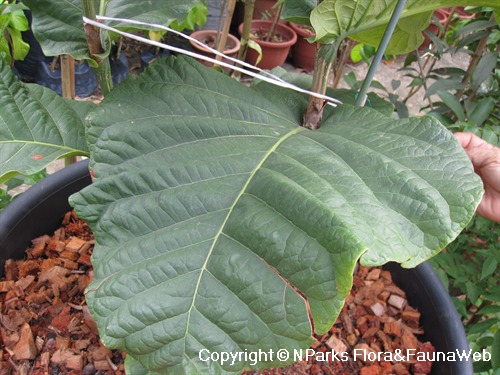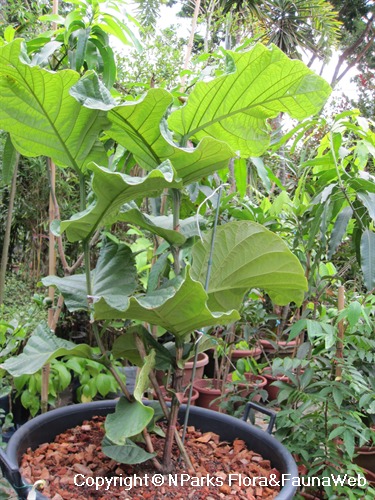
Name
Classifications and Characteristics
| Plant Division | Angiosperms (Flowering Seed Plants) |
|---|---|
| Plant Growth Form | Tree |
| Lifespan (in Singapore) | Perennial |
| Mode of Nutrition | Autotrophic |
Biogeography
| Native Distribution | Puerto Rico |
|---|---|
| Native Habitat | Terrestrial |
| Preferred Climate Zone | Tropical |
| Local Conservation Status | Non-native |
Description and Ethnobotany
| Growth Form | Small evergreen tree with a skinny trunk, able to grow up to 10 m tall. |
|---|---|
| Foliage | Large green obovate to rhomboidal leaves, alternate arrangement, measuring up to 60 cm long, wrinkled and margins recurved, surface glabrous. |
| Flowers | Small red flowers in a terminal inflorescence up to 30 - 45 cm long. |
| Fruit | Fruit ovoid in shape and orange-reddish, measuring about 5 - 7 mm long and 3 - 5 mm wide. |
| Etymology | Genus Coccoloba is from Greek words "kokkos" which means berry and "lobos" which means lobe or pod, and they refer to the grape-like fruits. It is also similar to the word "Cocolobis" which is a Spanish name for a kind of grape. Species rugosa means wrinkled and refers to the leaf or fruit surface of the plant. |
Landscaping Features
| Desirable Plant Features | Ornamental Foliage |
|---|---|
| Landscape Uses | Parks & Gardens, Small Gardens |
Fauna, Pollination and Dispersal
| Fauna Pollination Dispersal Associated Fauna | Butterfly-Attracting |
|---|---|
| Pollination Method(s) | Biotic (Fauna) |
Plant Care and Propagation
| Light Preference | Full Sun |
|---|---|
| Water Preference | Moderate Water |
| Plant Growth Rate | Moderate |
| Propagation Method | Seed |
Foliar
| Foliage Retention | Evergreen |
|---|---|
| Mature Foliage Colour(s) | Green |
| Foliar Arrangement Along Stem | Alternate |
Floral (Angiosperm)
| Flower Colour(s) | Red |
|---|---|
| Flower Grouping | Cluster / Inflorescence |
Fruit, Seed and Spore
| Mature Fruit Colour(s) | Orange, Red |
|---|
Image Repository
Others
| Master ID | 30587 |
|---|---|
| Species ID | 4896 |
| Flora Disclaimer | The information in this website has been compiled from reliable sources, such as reference works on medicinal plants. It is not a substitute for medical advice or treatment and NParks does not purport to provide any medical advice. Readers should always consult his/her physician before using or consuming a plant for medicinal purposes. |






